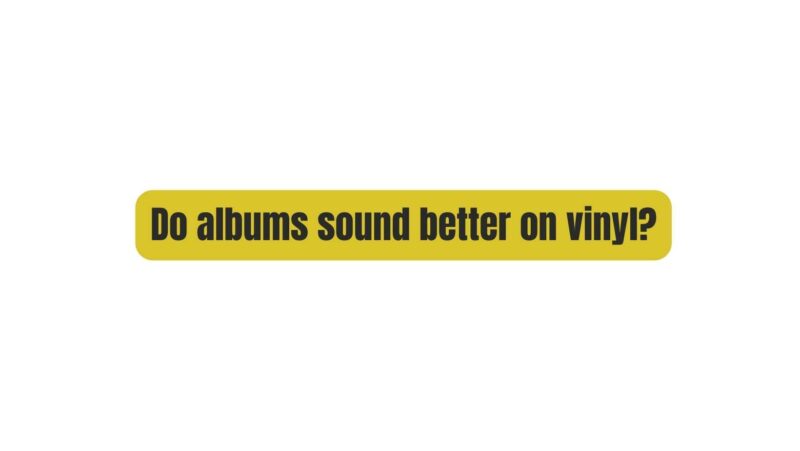In the age of digital streaming and instant downloads, vinyl records have experienced an unexpected resurgence. Audiophiles and music enthusiasts alike have been drawn to the nostalgic charm of vinyl, touting its warm, analog sound as superior to the cold precision of digital formats. But does this resurgence in vinyl’s popularity translate to a genuinely better listening experience, or is it merely a romanticized notion of the past? In this article, we’ll explore the factors that contribute to the vinyl sound and whether albums truly sound better on vinyl.
The Vinyl Resurgence
Before diving into the sonic qualities of vinyl, let’s first examine why vinyl records have made a comeback in a predominantly digital age. Vinyl’s resurgence can be attributed to several factors:
1. Tangibility and Collectibility
Vinyl records offer a tactile experience that digital files can’t match. The large album covers, the ritualistic act of placing the needle on the record, and the physicality of owning a vinyl collection provide a unique sense of connection to the music. Collectors and music enthusiasts appreciate vinyl’s inherent tangibility.
2. Nostalgia
For many, vinyl represents a bygone era of music consumption. Older generations fondly recall the crackling sounds and memories associated with their first record players. Vinyl’s revival taps into this nostalgia, and younger generations have also embraced the format, romanticizing the past even as they explore new music.
3. Audiophile Appeal
Audiophiles are particularly drawn to vinyl for its perceived sound quality. Vinyl records are analog, capturing sound as a continuous waveform, unlike digital recordings that sample and reproduce sound in discrete, numerical values. This difference in approach can lead to distinct sonic characteristics.
The Vinyl Sound: Warmth and Imperfections
The vinyl sound is often described as warm, rich, and full of character. But what exactly contributes to this unique sonic signature? Here are some key factors:
1. Analog Sound
Vinyl records store music in an analog format, which means that the audio signal is represented as a continuous waveform. This contrasts with digital formats, which break sound down into discrete samples. Analog audio is often associated with a smoother, more natural sound that some listeners find pleasing.
2. Vinyl Groove and Needle Interaction
When a vinyl record is played, a needle (stylus) travels through the grooves, translating the physical undulations of the groove into sound. This mechanical process can introduce subtle imperfections, such as surface noise, pops, and crackles. Some argue that these imperfections add character to the music and contribute to the overall warmth of vinyl.
3. Dynamic Range
Vinyl records have a limited dynamic range compared to modern digital formats like CD or high-resolution audio. This limitation can be seen as a drawback, as it may not faithfully reproduce the full spectrum of sound. However, some listeners appreciate the compression of the dynamic range as it can enhance the perception of warmth and depth.
4. Mastering Differences
Vinyl mastering often involves a different process than digital mastering. Audio engineers may apply specific EQ adjustments and compression techniques to optimize the music for vinyl playback. These mastering choices can affect the overall sound, adding to vinyl’s distinct sonic character.
Subjective Listening Experience
Whether albums sound better on vinyl is a highly subjective matter. Listener preferences play a significant role in determining which format they prefer. Here are some aspects to consider when evaluating the vinyl listening experience:
1. Vinyl’s Warmth vs. Digital Precision
Vinyl’s warmth is often praised for making music feel more organic and alive. Some argue that it adds an emotional depth that digital formats lack. On the other hand, digital formats are known for their precision and accuracy. The choice between warmth and precision depends on personal taste.
2. Imperfections vs. Perfection
As mentioned earlier, vinyl records can introduce imperfections such as pops and crackles. Some listeners find these imperfections endearing, while others see them as distractions. Digital formats are virtually free from such issues, providing a clean, uninterrupted listening experience.
3. Convenience and Portability
Vinyl records require more effort and equipment to play. They are less portable and convenient than digital music. For many, the convenience of digital formats outweighs any perceived audio quality differences.
4. Audio Equipment
The quality of your audio equipment plays a crucial role in how vinyl sounds. A high-quality turntable, cartridge, and speakers are essential for getting the best out of vinyl. Conversely, low-end equipment may not do justice to vinyl’s potential.
Conclusion: It’s All About Personal Preference
In the end, whether albums sound better on vinyl is a matter of personal preference. Vinyl records offer a unique listening experience characterized by warmth, analog charm, and imperfections. Digital formats, on the other hand, provide precision, convenience, and portability.
The resurgence of vinyl has enriched the music listening landscape by providing an alternative way to enjoy music. Rather than framing the vinyl vs. digital debate as a question of which is objectively better, it’s more productive to view it as an opportunity for music enthusiasts to explore diverse sonic experiences.
Ultimately, the “better” format depends on individual preferences and the context in which you’re listening. Some may prefer the cozy embrace of vinyl for a relaxed evening at home, while others may opt for the convenience of digital music on their daily commute. In a world with so many options, the choice is yours, and what truly matters is the joy and connection you find in the music, regardless of the format you choose.


